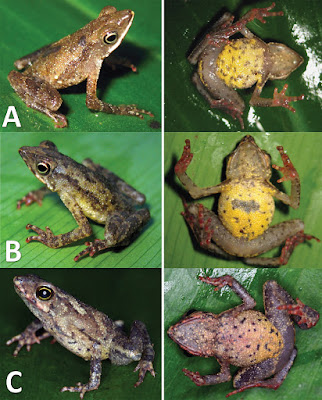[Most Recent Entries] [Calendar View]
Tuesday, February 16th, 2016
| Time | Event |
| 10:29a | [Herpetology • 2016] Gopherus evgoodei • The Desert Tortoise Trichotomy: Mexico hosts a third, New Sister-species of Tortoise in the Gopherus morafkai-G. agassizii group Abstract Desert tortoises (Testudines; Testudinidae; Gopherus agassizii group) have an extensive distribution throughout the Mojave, Colorado, and Sonoran desert regions. Not surprisingly, they exhibit a tremendous amount of ecological, behavioral, morphological and genetic variation. Gopherus agassizii was considered a single species for almost 150 years but recently the species was split into the nominate form and Morafka’s desert tortoise, G. morafkai, the latter occurring south and east of the Colorado River. Whereas a large body of literature focuses on tortoises in the United States, a dearth of investigations exists for Mexican animals. Notwithstanding, Mexican populations of desert tortoises in the southern part of the range of G. morafkai are distinct, particularly where the tortoises occur in tropical thornscrub and tropical deciduous forest. Recent studies have shed light on the ecology, morphology and genetics of these southern ‘desert’ tortoises. All evidence warrants recognition of this clade as a distinctive taxon and herein we describe it as Gopherus evgoodei sp. n. The description of the new species significantly reduces and limits the distribution of G. morafkai to desert scrub habitat only. By contrast, G. evgoodei sp. n. occurs in thornscrub and tropical deciduous forests only and this leaves it with the smallest range of the three sister species. We present conservation implications for the newly described Gopherus evgoodei, which already faces impending threats. Keywords: Gopherus agassizii, Gopherus morafkai, Sinaloa, Sonora, Testudinidae, Xerobates Taylor Edwards, Alice Karl, Mercy Vaughn, Philip Rosen, Christina Meléndez Torres and Robert W. Murphy. 2016. The Desert Tortoise Trichotomy: Mexico hosts a third, New Sister-species of Tortoise in the Gopherus morafkai-G. agassizii group. ZooKeys 562: 131-158. DOI: 10.3897/zookeys.562.6124 The third sister: Long-suspected third desert tortoise species proven to exist in Mexico |
| 3:14p | [Herpetology • 2016] Amazophrynella javierbustamantei • Uncovering the Diversity in the Amazophrynella minuta Complex: Integrative Taxonomy reveals A New Species of Amazophrynella (Anura, Bufonidae) from southern Peru Abstract A new species of the genus Amazophrynella (Anura, Bufonidae) is described from the departments of Madre de Dios, Cusco and Junin in Peru. An integrative taxonomy approach is used. A morphological diagnosis, morphometrics comparisons, description of the advertisement call, and the phylogenetic relationships of the new species are provided. Amazophrynella javierbustamantei sp. n. differs from other species of Amazophrynella by: intermediate body-size (snout-vent length 14.9 mm in males, n = 26 and 19.6 mm in females, n = 20), tuberculate skin texture of body, greatest hand length of the Amazophrynella spp. (3.6 mm in males, n = 26 and 4.6 mm in females, n = 20), venter coloration yellowish, tiny rounded black points covering the venter, and thirteen molecular autapomorphies in the 16S RNA gene. Its distribution varies from 215 to 708 m a.s.l. This discovery highlights the importance of the remnant forest in preserving the biodiversity in Peru, and increase in seven the species formally described in the genus Amazophrynella. Keywords: Amphibian, Tree Toad, conservation, Southern Peru, integrative taxonomy Rommel R. Rojas, Juan Carlos Chaparro, Vinicius Tadeu Carvalho, Robson Avila, Izeni P. Farias, Tomas Hrbek and Marcelo Gordo. 2016. Uncovering the Diversity in the Amazophrynella minuta Complex: Integrative Taxonomy reveals A New Species of Amazophrynella (Anura, Bufonidae) from southern Peru. ZooKeys. 563: 43-71. DOI 10.3897/zookeys.563.6084 Resumen Describimos una nueva especie del género Amazophrynella (Anura, Bufonidae) del Perú de los Departamentos de Madre de Dios, Cusco y Junin de Peru. Utilizamos un método de taxonomía integrativa. Obtuvimos la diagnosis morfológica, comparaciones morfométricas, descripción del canto de reproducción y las relaciones filogenéticas de la nueva especie. A. javierbustamantei sp. n. difiere de las otras Amazophrynella spp. por poseer tamaño medio (Hocico-cloaca en machos 16.9 mm, n = 26 y en hembras 19.6 mm, n = 20); textura de la piel tuberculada; tamaños de las manos mayores (3.6 mm en machos, n = 26 y 4.6 mm en hembras, n = 20); coloración ventral amarillento-pálida, pequeños puntos redondos de color negro en el vientre y por trece autopomorfias moleculares en el gen 16S RNA. Su distribución varía desde 215 m hasta 708 m a.s.n.m. Este descubrimiento resalta la importancia de los remanentes de la selva Peruana en términos de conservación, e incrementa en siete las especies formalmente descritas en del género Amazophrynella. Resumo Descrevemos uma nova espécie do gênero Amazophrynella (Anura, Bufonidae) dos departamentos de Madre de Dios, Cusco e Junin do Peru. Utilizamos um método de taxonomia integrativa. Apresentamos a diagnose morfológica, comparações morfométricas, descrevemos o canto de anúncio e geramos uma hipótese filogenética da nova espécie. Amazophrynella javierbustamantei sp. n. difere das outras Amazophrynella spp. por possuir tamanho médio (Comprimento rostro-cloacal 16.9 mm em machos, n = 26 e 19.6 mm em fêmeas, n=20); textura da pele tuberculada; tamanhos das mãos maiores (3.6 mm em machos, n = 26 e 4.6 mm em fêmeas, n = 20); coloração ventral amarelo-clara, coberta por pequenos pontos redondos pretos e por treze autapomorfias moleculares no gene 16S RNA. Sua distribuição varia entre os 215 m até os 708 m a.n.m. Nossa descoberta aumenta a importância dos remanescentes da floresta Peruana em termos de conservação e incrementa em sete as espécies formalmente descritas no gênero Amazophrynella. Palabras claves: Anfibios, Sapo del árbol, conservación, Sur del Perú, taxonomía integrativa Palavras chaves: Anfíbios, Sapo do arvore, conservação, Sul do Peru, taxonomia integrativa |
| << Previous Day |
2016/02/16 [Calendar] |
Next Day >> |










